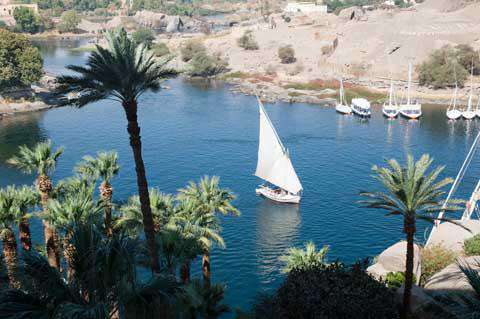For starters, you'll certainly want to grab a cab to the Unfinished Obelisk. Stand in awe at this massive structure carved straight from bedrock. As of now, it is the largest known ancient obelisk. Imagine what it would have looked like if it had been finished. It would have likely stood 42 meters tall and weighed 1,200 tons.
The real historical delight, however, is located on the West Bank. This area is home to the Tomb of the Nobles. Wander through and visit tombs of princes from the old kingdoms all the way up to the time of the Romans. The 6th Dynasty tombs are the most fascinating with hieroglyphic biographies and inscriptions. They tell the tales of the nobleman's journey to Africa. Be warned, many locals will try to block off passages and ask for a small fee for entrance. Give them a simple, "no thanks," and they should leave you alone.
For a really neat experience, take a trip to the Philae Temple. Built as a monument to the Egyptian goddess Isis, this is the last temple built in the classical Egyptian architecture. But this is not where it was originally built in 690 BC. It has been moved by archaeologists to protect it from the flood of Lake Nasser. You still see the original home to the Philae Temple. There is an underwater island with steel columns sticking up, and that is where this beautiful temple once lived.
Another amazing rescue is a bit out of the way, but worth the visit. In the small village of Abu Simbel are stunning temples relocated to the village just before the flood. The Great Temple of Ramses II is massive and intimidating, which is perfect given it was meant to scare off enemies approaching the area as they traveled down the Nile.
For a little more unique background to the area, make a stop at the Nubia Museum. This attraction is rarely visited, so you won't have to deal with many crowds. Opened in 1997, this museum details what was lost beneath Lake Nasser. Beginning in 4500 BC and coming all the way to present day, you'll come across prehistoric artifacts, ancient Coptic and Islamic art and horse armor found in tombs form the 5th and 6th centuries BC.
This region is typically meat for historical sightseeing, but there are activities to explore. You can always rent a bike for a leisurely ride across the Nile, or take a camel ride to the Monastery of St. Simeon.
One opportunity you won't want to miss, though, is a trip to one of the Nubian Villages. A short boat ride takes you to small village where people keep crocodiles as pets. You are welcome to hold them, have a drink and wander the small and sleepy villages of locals.
A nice way to explore destinations in Aswan is with local tours that last just a few hours. This way you can see as much as possible in an efficient way with knowledgable guides. Prices vary by the type of activity or tour, the dates, and the size of the group. Here are a few of the highest rated tours by previous visitors:
- Private Tour in Aswan : Felucca and Nubian village for $23 details
- Private Day Tour to Abu Simbel Temples and Nubian Village From Aswan for $180 details
- Day Tour To Abu Simbel Temples for $150 details
A few typical prices for sights, activities, and entry fees in Aswan are listed below. These actual costs are from real travelers to provide you with an idea how much you might need to spend. Your individual costs will vary based on which activities you do, which attractions or museums you visit, and how often you participate in free or low-cost activities.
 A felucca on the Nile river
A felucca on the Nile river

 Budget Your Trip is all about finding out how much everything costs so that you can travel cheaper and longer. Created by avid travelers Laurie and Bryan, our goal is to help you plan your next trip on the right budget. With average daily travel costs that are calculated from the budgets of real travelers, plus an analysis of hotel and tour prices, you can find out how much money you need to plan your next adventure. We also have plenty of travel advice, accommodation reviews, and activity suggestions.
Budget Your Trip is all about finding out how much everything costs so that you can travel cheaper and longer. Created by avid travelers Laurie and Bryan, our goal is to help you plan your next trip on the right budget. With average daily travel costs that are calculated from the budgets of real travelers, plus an analysis of hotel and tour prices, you can find out how much money you need to plan your next adventure. We also have plenty of travel advice, accommodation reviews, and activity suggestions.